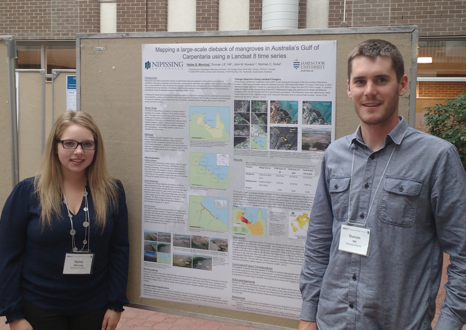NU and Australian researchers collaborate on climate change caused die-off

Undergraduate student Hailey Morning (l) and MESc student Duncan Hill (r)
Researchers from Nipissing University’s Geography department are part of a study published in the journal Marine and Freshwater Research that points a finger at climate change as the cause of a massive wetland die-off in Australia. Geography professor Dr. John Kovacs and his summer research assistants, MESc student Duncan Hill and undergraduate student Hailey Morning, co-authored the paper with Australian scientists.
The study records and documents the most severe and notable instance ever reported of sudden and widespread dieback of mangrove vegetation. Between late 2015 and early 2016, extensive areas of mangrove tidal wetland vegetation died along 1000 km of the shoreline of Australia’s remote Gulf of Carpentaria.
Last summer Nipissing’s geographers processed a series of historical satellite images to identify when the die-off began and to determine its extent. Using digital change detection techniques they determined that over 7000 hectares of the forested wetlands were lost within a period of just a few months. According to their Australian colleagues, this is most likely attributable to an exceptional dry and hot period in 2015-16. The impacts matched with the recently reported Great Barrier Reef coral bleaching event in the adjacent waters which is believed to have occurred as the result of large scale changes in global climates.
The work has drawn considerable international attention and has been featured in many mainstream media forums:
- Smithsonian.com
- The Huffington Post
- The Guardian
- The Guardian (2)
- NATURE
- Australian Broadcasting Corporation
- NASA Earth Observatory
